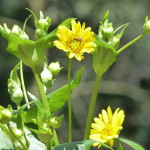One of the most interesting wildflowers has a long blooming season from mid-summer until early September and is host to a vast diversity of wildlife.
The Cup Plant (Silphium perfoliatum) gets its name from cups that form along the square stem of this large Silphium. Heavy dew and rain channel down leaves and stems to collect in the small cups of the leaves that gather around the stalks (perfoliatum) where birds and insects sip the moisture. This plant is nature’s watering hole, but it does even more to attract wildlife.
The showy flowers are sunflower-like and their brilliant color reflects the late summer hues of male goldfinches. This bird loves cup plants, where it drinks water, snacks on insects attracted to it and later in the fall eats the seeds. When in bloom cup plants are loaded with pollinators. Bumblebees and yellow and black swallowtail butterflies are frequent guests.
Cup plants live from the Great Plains east to the Atlantic and usually can be found in moist soil on the edge of woods. They thrive in yards but beware! This plant can grow to be ten feet tall. They are easily propagated from roots and tend to spread.
We have a big clump of cup plants near our back deck at Winding Pathways and enjoy watching a never ending stream of insects and birds visit the blooms. They are tall and block vision, so when the last seed is gleaned by an autumn goldfinch we cut down the stems but look forward to next year’s regrowth.


